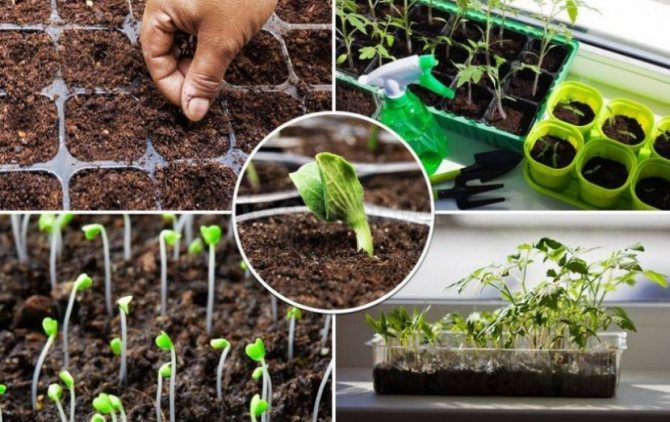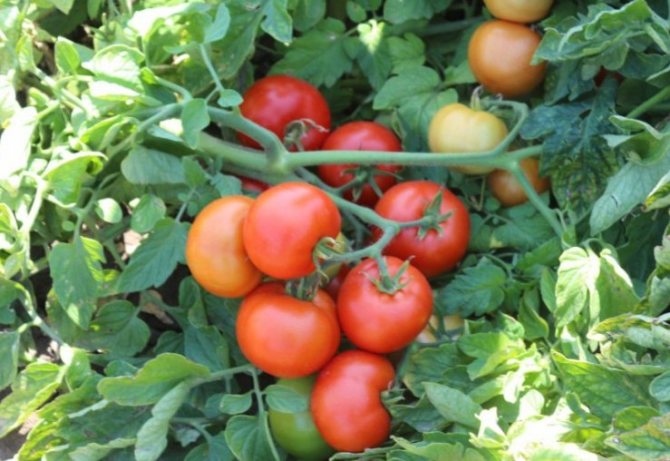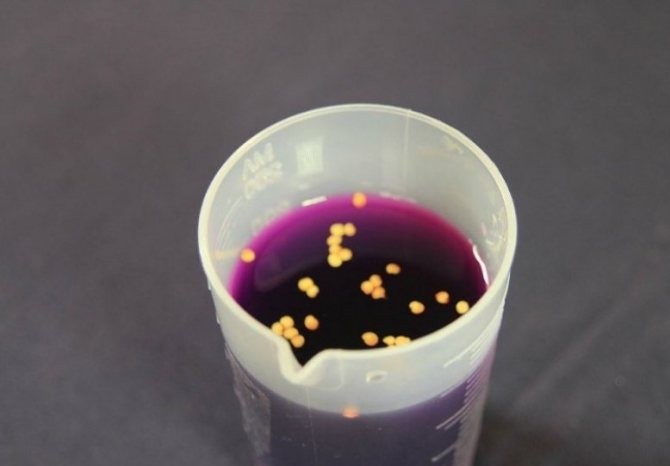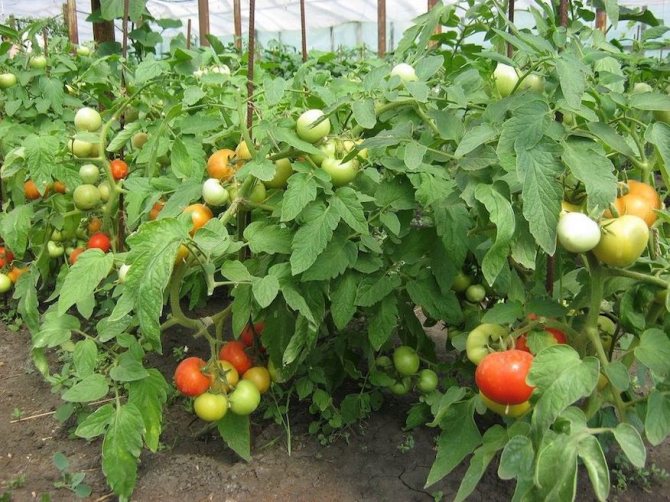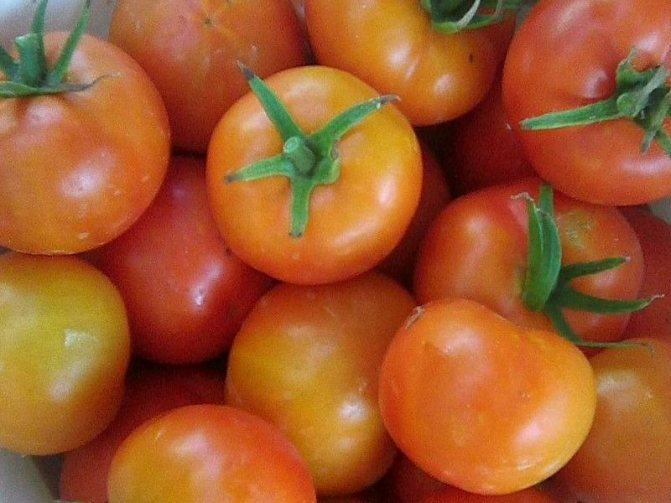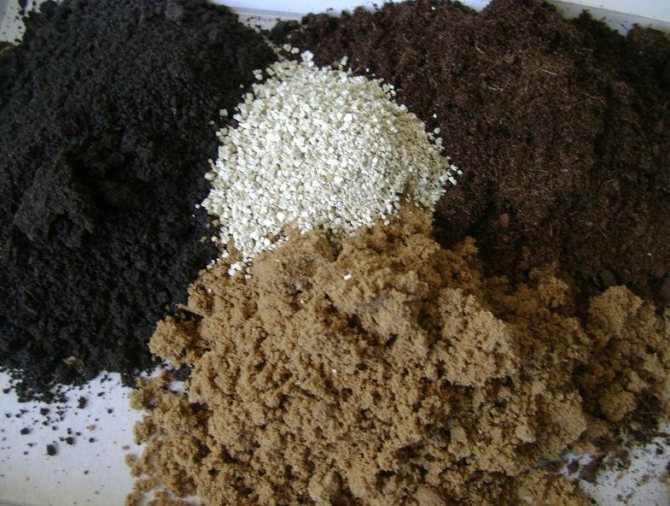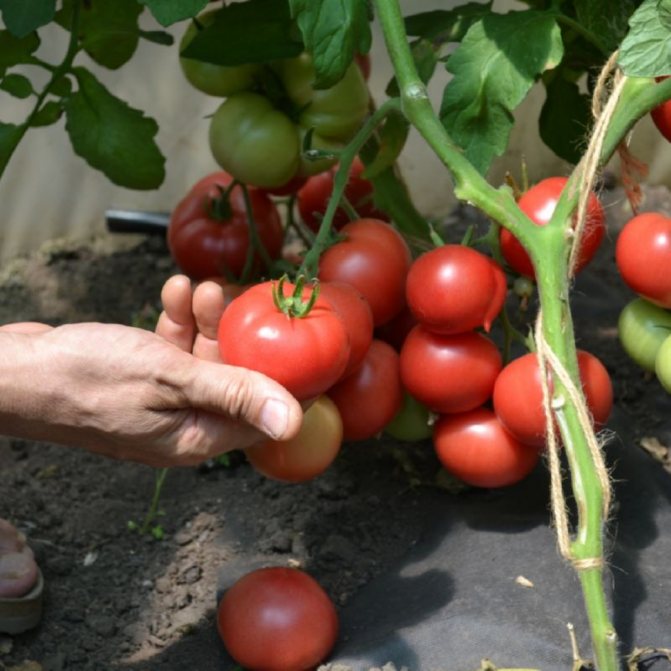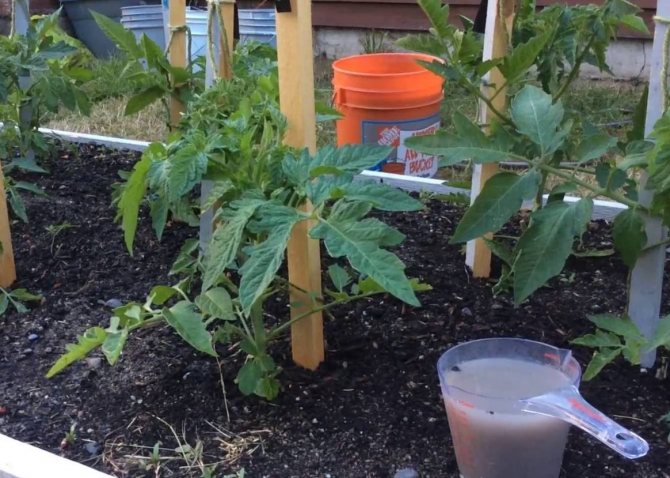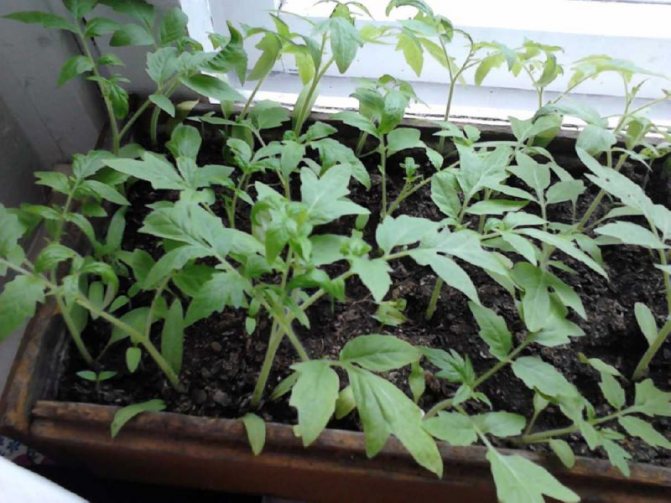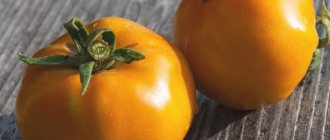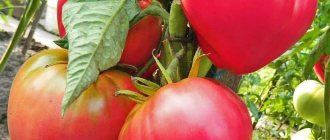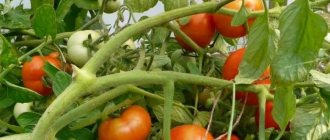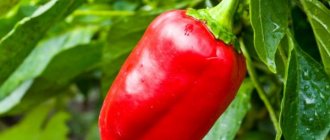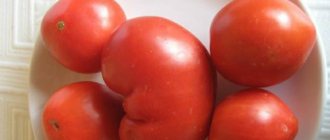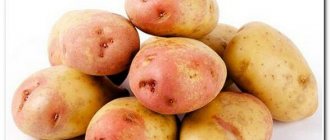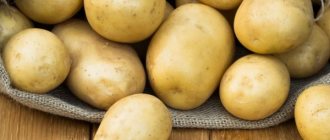Last year I decided to start planting tomatoes closely. Together with the proven varieties, I planted several new ones for testing. Among them there is an early maturing variety "Katya F1". Since our climate is unpredictable, especially in the off-season, it was this variety that was resistant to temperature changes that I was advised to plant in open ground.
There are many more advantages of these tomatoes: great taste and good yield. I tell you what this variety is and how to grow it competently in order to get an excellent harvest.
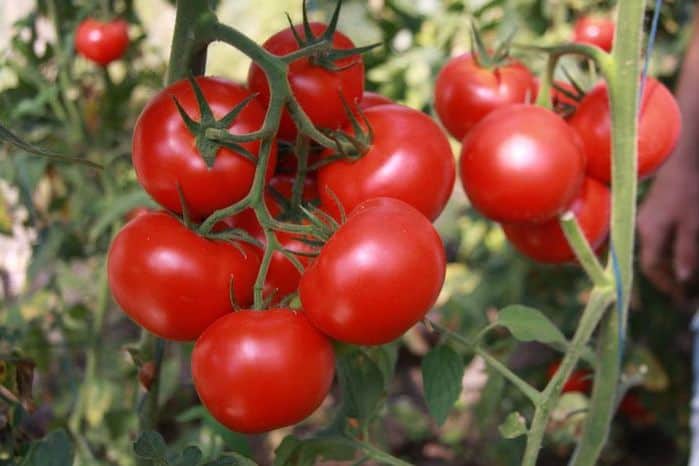
Tomato "Katya" F1: variety description
| Variety name | Katya |
| general description | An early ripe, determinant hybrid of tomatoes for growing in greenhouses and open field. |
| Originator | Russia |
| Ripening period | 75-80 days |
| The form | Fruits are round or flat-round |
| Color | Red |
| Average weight of tomatoes | 120-130 grams |
| Application | Consumed fresh, for juice and preservation |
| Variety yield | 8-15 kg per square meter |
| Growing features | Seedling growing is recommended |
| Disease resistance | Resistant to the most dangerous diseases |
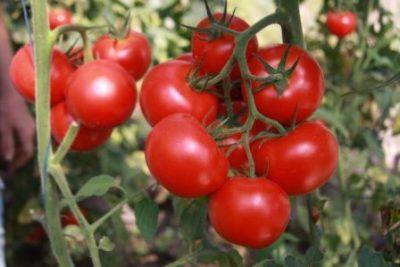

The tomato was bred by Russian breeders in the 21st century. Katya is an F1 hybrid. From the moment of sowing the seeds to the appearance of ripe fruits, it usually takes from 75 to 80 days, which is why these tomatoes are called early ripening. The determinant bushes of this plant reach a height of 60 to 60 centimeters and are not standard. Read about indeterminate varieties here.
They are characterized by medium foliage. These tomatoes can be grown not only in greenhouses, greenhouses or under a film, but also in the open field. They are excellent at tolerating both drought and heavy rainfall, and are highly resistant to known diseases such as apical rot, Alternaria, Fusarium, Verticillium, late blight and tobacco mosaic virus.
When grown in open ground, from 8 to 10 kilograms of crop are harvested from one square meter of planting, and when grown in greenhouses - up to 15 kilograms... The yield of marketable fruits is 80-94% of the total harvest.
You can compare the yield of the variety with others in the table below:
| Variety name | Yield |
| Katya | 8-15 kg per square meter |
| Gulliver | 7 kg per bush |
| Lady Shedi | 7.5 kg per square meter |
| Honey heart | 8.5 kg per square meter |
| Fat jack | 5-6 kg per bush |
| Doll | 8-9 kg per square meter |
| Summer resident | 4 kg per bush |
| Lazy | 15 kg per square meter |
| The president | 7-9 kg per square meter |
| King of the market | 10-12 kg per square meter |
This type of tomato is characterized by the formation of simple inflorescences and the presence of joints on the stalks. The first inflorescence forms above the fifth leaf. 8-9 fruits are tied in each hand.
Tomato Katya has the following advantages:
- excellent taste characteristics and commercial qualities of fruits;
- disease resistance;
- unpretentiousness;
- high productivity;
- early maturity;
- good transportability of fruits and their resistance to cracking;
- uniform ripening of tomatoes, which greatly facilitates harvesting.
Seed preparation
High-quality tomato planting material is the key to healthy seedlings and an excellent harvest. Purchase seeds in proven seed shops, specialized shopping centers from trusted suppliers.Before sowing, the seeds are soaked for 15–20 minutes in a pink solution of potassium permanganate.
See also Description, characteristics and cultivation of tomato Lazy


Treatment with growth stimulants, such as auxin, succinic acid, activates the growth processes of the seed, accelerates germination.
Calibration
Sometimes among the purchased seeds, and even more so collected independently, there may be defective, puny, underdeveloped grains. Such specimens must be discarded. A sure way is to flood the seeds with cool water and remove any that have floated to the surface. The floating planting material will not sprout, you need to get rid of it.
Disinfection
The procedure allows you to get rid of many problems in the future. Etching is recommended to be carried out with fungicides and potassium permanganate.
Flushing
When self-collecting seeds, particles of fruit pulp remain on them. Organic residues rot over time and become a source of seed infection.
The grains should be thoroughly rinsed. First of all, they are soaked for a day in cool water to separate the remaining pulp. Then the material is filtered through a double layer of gauze, washed several times in running water. Clean grains are laid out on a flat surface to dry.
Expert opinion
Stanislav Pavlovich
Gardener with 17 years of experience and our expert
Ask a Question
The moisture content of the seeds should not exceed 12%. Dry seeds are stored in rag bags or paper bags. Never keep grains in a plastic bag.
Hardening
For hardening, the seeds are placed in the cold for a few minutes, but the seeds cannot be kept in cold water.
Characteristics
- The fruits of tomatoes of this variety are round or flat-round in shape.
- Weight is about 120-130 grams.
- In an immature form, they are light green, and in a mature form, they are bright red in color without a greenish spot near the stalk.
- They taste good.
- Each fruit has three or four nests.
- The dry matter content is 4.6%.
- These tomatoes do not crack, ripen evenly and have a long shelf life.
- They have a high density, due to which they perfectly tolerate transportation.
You can compare such an indicator as the weight of fruits with other varieties in the table below:
| Variety name | Fruit weight |
| Katya | 120-130 grams |
| Bobcat | 180-240 |
| Russian size | 650-2000 |
| Podsinskoe miracle | 150-300 |
| American ribbed | 300-600 |
| Rocket | 50-60 |
| Altaic | 50-300 |
| Yusupovsky | 500-600 |
| Premier | 120-180 |
| Honey heart | 120-140 |
Katya's tomatoes can be eaten fresh, as well as used for preservation, making tomato paste and juice.
Read on our website: How to get an excellent harvest of tomatoes in the open field? How to grow delicious tomatoes all year round in a greenhouse? What are the agrotechnical subtleties of growing early varieties of tomatoes? Which tomato fertilizer should you use to get the best results?
Photo
Below you can see the fruits of the Katya tomato in the photo:
Growing features
These tomatoes were included in the State Register of the Russian Federation for the North Caucasus region for growing in the open field on personal subsidiary plots. Katya tomatoes are recommended to be grown in seedlings.
To get an early harvest, seeds must be sown in March in containers filled with a nutrient substrate. You can plant in special cups, other containers or mini-greenhouses. To speed up the process, use growth stimulants. After the development of the cotyledons, the plants are picked, at this moment the plants need to be fed. In open ground, seedlings with a height of 15 to 20 centimeters can be planted only when the likelihood of nighttime cold snaps has completely passed.
Important: The distance between the holes should be 45 centimeters and the holes should be deep.
The best place to plant these plants is in a well-lit area, but areas with little shade will also work. Bushes must be formed into two or three stems.
These tomatoes need to be pinned and tied to a support. Potash fertilizers should be applied regularly to the soil. Do not forget about abundant regular watering and periodic loosening of the soil. As soon as the first fruit ovaries are formed, fertilizers must be applied every day. Mulching will help control weeds.
Read more about fertilizers for tomatoes:
- Organic, mineral, ready-made, TOP of the best.
- Yeast, iodine, ash, hydrogen peroxide, ammonia, boric acid.
- For seedlings, foliar, when picking.
Also read on our website: How to prepare the soil in the greenhouse in the spring? What types of soil for tomatoes are there? Which soil should be used for seedlings, and which is suitable for mature plants in greenhouses?
Landing rules
This type of tomato is recommended for planting in almost all regions of Russia. It will thrive especially well in areas with hot and dry summers. But if the climate is very cold and difficult, then use a greenhouse to grow vegetables.
You need to start planting in the second half of March, and complete the landing in early April. Then in July it will already be possible to get a wonderful harvest. The optimum temperature for growing is +13. If there is less, then development and growth will stop.
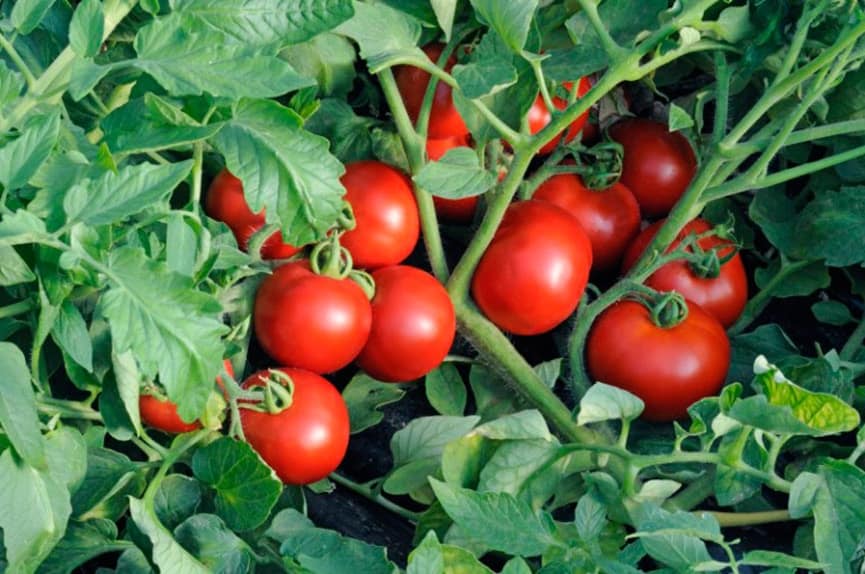

Growing seedlings
- Prepare seed containers in advance. They must be wide enough so that the root system of the sprouts has an area for growth.
- Make small holes at the bottom. Drainage is needed for air intake. Moisture should not stagnate in the roots so that decay does not begin.
- Soak the seeds in a potassium permanganate solution for half an hour. Some gardeners warm up the seed at a temperature of +30 degrees and gradually increase it to +50. Such disinfection will save plants from diseases and strengthen their immunity.
- When planting seeds in the soil, keep the air temperature at least +23 degrees, otherwise the seeds will not sprout.
- To speed up the process of germination of seeds, they are laid out on a damp cloth and covered with foil, put the dishes in a warm place.
- When the shoots appear, the shoots are moved with tweezers into the prepared substrate in the container. The soil can be purchased universal or mix sand with garden soil and peat in equal parts. Drizzle with boiling water for disinfection before planting.
- Spread the seeds into the grooves as spaced as needed for root growth. Sprinkle a little earth on top.
- Cover with plastic wrap or cellophane and place containers in a warm place. Next, we are waiting for seedlings.
- When the first shoots with several leaves appear, the shelter is removed, and the seedlings are rearranged to a lighted place.


Picking
- Watch carefully so that the sprouts do not stretch out. And for this you need to plant the bushes in time.
- Moisten the soil in the container well, and then carefully, in turn, remove each bush along with a clod of earth. The root system must be removed by 1/3.
- When planting shoots in separate pots, deepen the stem to the level of growth of the last leaves. Gently compact the soil near the root collar. Water the ground well.
- Then rearrange the pots in a place with diffused light. It is not worth placing in direct sunlight on the south side of the room so that the leaves and stem do not get burned.
Take out the seedlings to fresh air regularly, but gradually increase the time. This will harden the plants and adapt them for outdoor growth. At first, 2 - 3 hours is quite enough, then increase, and at the end leave the bushes outside for a whole day.
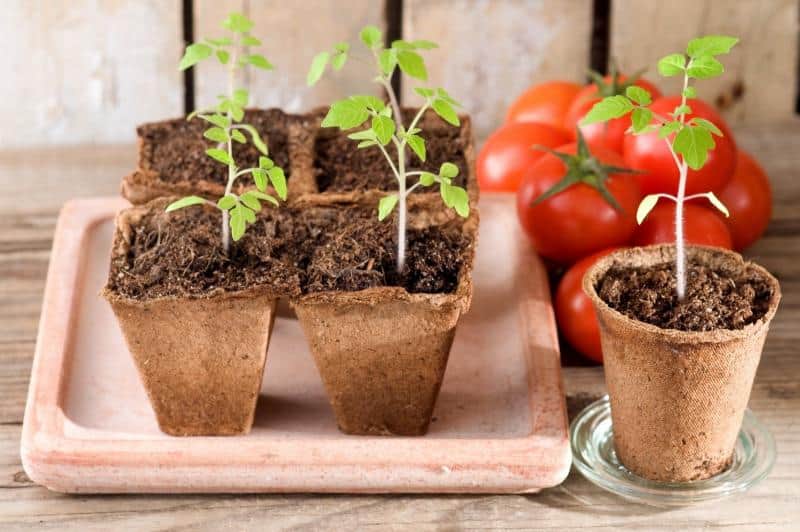

Watch the stems and leaves harden.As soon as their light green color acquires a bluish tint, then the sprouts can be transplanted into open ground.
Soil preparation
The Katya F1 variety feels very comfortable in sandy loam and loamy soil. Therefore, fertilizing and fertilization should be chosen depending on what kind of soil you have.
- If the soil is with a high level of acidity (usually sorrel, horsetail), then at least once every few years add dolomite flour or lime at the rate of 250 g per 1 m2.
- If the soil is clay, then add 1 bucket of manure or compost per 1 m2. Alternatively: mix the sand with a urea solution (150 g per bucket of water).
Landing
Perform the procedure in May, when the heat is finally restored. Remove the grown seedlings with several healthy leaves on the stem from the container. Wet the earth in advance. Carefully separate the sprouts from each other, the roots should remain with a clod of earth.
- Dig small holes in the ground, observing the distance between the seedlings. There should be no more than 4 pieces per 1 m2.
- Pour a bucket of water into each hole.
- Arrange the seedlings and cover with earth. Pack the soil and water liberally.
- Embed each seedling no more than half the length of the stem.
After planting, moisten the soil regularly, at least 2 to 3 times a week. Watering should be done in the morning or evening.
Watering plants under the scorching rays is not worth it. The amount of water required for this variety is 700 - 900 ml for each bush.
Loosen the soil and remove weeds regularly. You can mulch the soil around the bushes with compost or manure. The yield is very good.
From 65% to 90% of the harvested fruits are suitable for food. If the care was correct, the place for planting was correctly chosen and the soil was fertilized, as well as watering and loosening of the soil was carried out on time, then the yield is almost 100%.
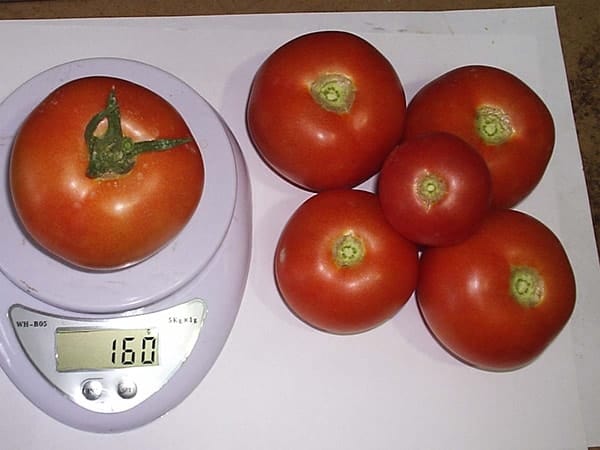

Diseases and pests
This variety is resistant to the most dangerous diseases of tomatoes, and from all others it can be saved with the help of fungicidal preparations and other proven methods. To prevent the invasion of pests - Colorado beetles, thrips, aphids, spider mites, treat the garden with insecticidal preparations in time.
Although Katya's tomatoes have appeared relatively recently, they have already gained popularity. Gardeners love this variety for its unpretentiousness to weather conditions, high yield and resistance to diseases.
Testimonials
Tomatoes of the "Katya" F1 variety are very much appreciated by vegetable growers for their high yield, unpretentiousness in growing. Resistance to a large number of diseases ensures a stable and high yield. Judging by the large number of reviews, the fruits of the hybrid are pleasantly juicy and have a pleasant taste.
Galina Stepanovna, 54 years old, Nizhny Novgorod region
Katya has been planting tomatoes for a long time, always happy with the harvest. Seeds sprout almost all, the seedlings grow strong. I plant in a greenhouse and tie up the bushes so that the branches do not break. This year I bought the seeds Pink Katya. They are a little tastier and their color is beautiful.
Ilyicheva Milena, 47 years old, Stavropol
We grow Katya tomatoes in the open field. Strong bushes do not get sick, we use purchased products from pests. We collect a large harvest every year. The tomatoes are beautiful, round, red. It is not difficult to take care of them, just make sure that the bush with the fruits does not break off, you need to tie it.
Semenova Tatiana, 63 years old, Smolensk
We bought tomato seeds of the Katya variety for testing. They ripen early, you can put them in a salad or make preparations. It's easy to take care of Katya; when we were buying seeds, we were warned that their branches were breaking. We will plant this variety next year. I have already advised my neighbor such tomatoes.
Video
We offer you to get acquainted with a video review of various varieties of tomato, including the hybrid variety "Katya F1":
In the table below you will find links to articles about tomatoes with different ripening periods:
| Mid-season | Late ripening | Super early |
| Nikitich | Premier | Alpha |
| Funtik F1 | Grapefruit | Pink Impression |
| Crimson Sunset F1 | De Barao Giant | Golden stream |
| Rise F1 | Yusupovsky | The miracle of the lazy |
| Mikado | Bull heart | Salting miracle |
| Azure Giant F1 | Rocket | Sanka |
| Uncle Styopa | Altaic | Locomotive |
If you find an error, please select a piece of text and press Ctrl + Enter.
Landing in open ground
Tomatoes are planted in the ground in the last days of May. The soil should warm up to 15 degrees.
Site requirements
The site should be dug up in the fall. Tomatoes do not like drafts, therefore, to grow plants, you need to choose protected from the wind, bright places.
Timing recommendations
The optimal time for planting seedlings is the end of May. Do not rush to plant, the soil should warm up.
Landing scheme
Tomatoes are planted in a checkerboard pattern. The aisles are mulched with grass, hay, compost. No more than 2-3 bushes are grown on one square meter.


